The Anh Han
KERAIA: An Adaptive and Explainable Framework for Dynamic Knowledge Representation and Reasoning
May 07, 2025



Abstract:In this paper, we introduce KERAIA, a novel framework and software platform for symbolic knowledge engineering designed to address the persistent challenges of representing, reasoning with, and executing knowledge in dynamic, complex, and context-sensitive environments. The central research question that motivates this work is: How can unstructured, often tacit, human expertise be effectively transformed into computationally tractable algorithms that AI systems can efficiently utilise? KERAIA seeks to bridge this gap by building on foundational concepts such as Minsky's frame-based reasoning and K-lines, while introducing significant innovations. These include Clouds of Knowledge for dynamic aggregation, Dynamic Relations (DRels) for context-sensitive inheritance, explicit Lines of Thought (LoTs) for traceable reasoning, and Cloud Elaboration for adaptive knowledge transformation. This approach moves beyond the limitations of traditional, often static, knowledge representation paradigms. KERAIA is designed with Explainable AI (XAI) as a core principle, ensuring transparency and interpretability, particularly through the use of LoTs. The paper details the framework's architecture, the KSYNTH representation language, and the General Purpose Paradigm Builder (GPPB) to integrate diverse inference methods within a unified structure. We validate KERAIA's versatility, expressiveness, and practical applicability through detailed analysis of multiple case studies spanning naval warfare simulation, industrial diagnostics in water treatment plants, and strategic decision-making in the game of RISK. Furthermore, we provide a comparative analysis against established knowledge representation paradigms (including ontologies, rule-based systems, and knowledge graphs) and discuss the implementation aspects and computational considerations of the KERAIA platform.
FAIRGAME: a Framework for AI Agents Bias Recognition using Game Theory
Apr 22, 2025Abstract:Letting AI agents interact in multi-agent applications adds a layer of complexity to the interpretability and prediction of AI outcomes, with profound implications for their trustworthy adoption in research and society. Game theory offers powerful models to capture and interpret strategic interaction among agents, but requires the support of reproducible, standardized and user-friendly IT frameworks to enable comparison and interpretation of results. To this end, we present FAIRGAME, a Framework for AI Agents Bias Recognition using Game Theory. We describe its implementation and usage, and we employ it to uncover biased outcomes in popular games among AI agents, depending on the employed Large Language Model (LLM) and used language, as well as on the personality trait or strategic knowledge of the agents. Overall, FAIRGAME allows users to reliably and easily simulate their desired games and scenarios and compare the results across simulation campaigns and with game-theoretic predictions, enabling the systematic discovery of biases, the anticipation of emerging behavior out of strategic interplays, and empowering further research into strategic decision-making using LLM agents.
Do LLMs trust AI regulation? Emerging behaviour of game-theoretic LLM agents
Apr 11, 2025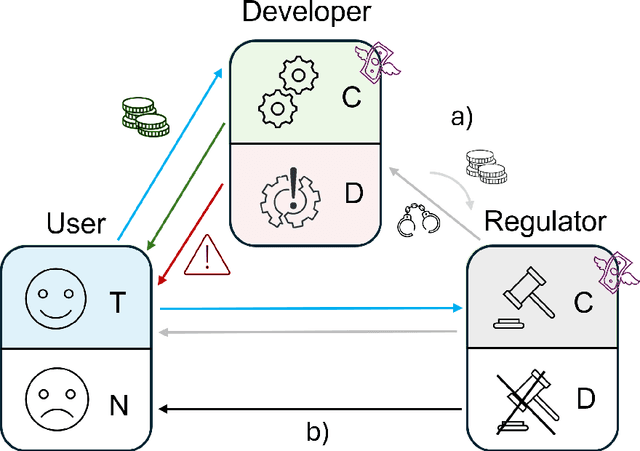
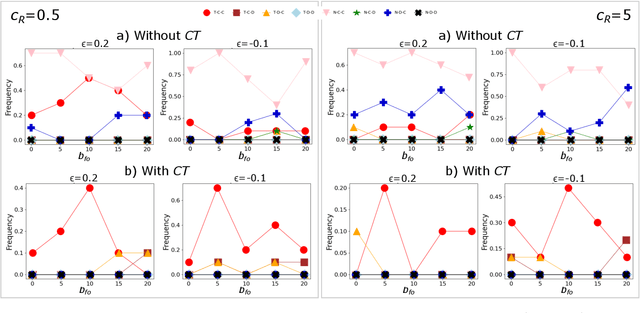
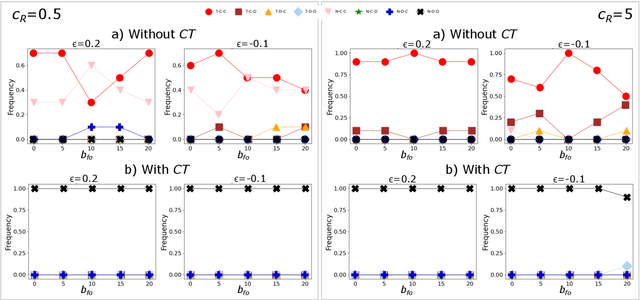
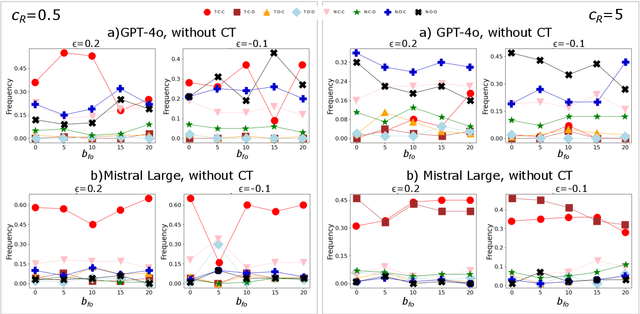
Abstract:There is general agreement that fostering trust and cooperation within the AI development ecosystem is essential to promote the adoption of trustworthy AI systems. By embedding Large Language Model (LLM) agents within an evolutionary game-theoretic framework, this paper investigates the complex interplay between AI developers, regulators and users, modelling their strategic choices under different regulatory scenarios. Evolutionary game theory (EGT) is used to quantitatively model the dilemmas faced by each actor, and LLMs provide additional degrees of complexity and nuances and enable repeated games and incorporation of personality traits. Our research identifies emerging behaviours of strategic AI agents, which tend to adopt more "pessimistic" (not trusting and defective) stances than pure game-theoretic agents. We observe that, in case of full trust by users, incentives are effective to promote effective regulation; however, conditional trust may deteriorate the "social pact". Establishing a virtuous feedback between users' trust and regulators' reputation thus appears to be key to nudge developers towards creating safe AI. However, the level at which this trust emerges may depend on the specific LLM used for testing. Our results thus provide guidance for AI regulation systems, and help predict the outcome of strategic LLM agents, should they be used to aid regulation itself.
Media and responsible AI governance: a game-theoretic and LLM analysis
Mar 12, 2025Abstract:This paper investigates the complex interplay between AI developers, regulators, users, and the media in fostering trustworthy AI systems. Using evolutionary game theory and large language models (LLMs), we model the strategic interactions among these actors under different regulatory regimes. The research explores two key mechanisms for achieving responsible governance, safe AI development and adoption of safe AI: incentivising effective regulation through media reporting, and conditioning user trust on commentariats' recommendation. The findings highlight the crucial role of the media in providing information to users, potentially acting as a form of "soft" regulation by investigating developers or regulators, as a substitute to institutional AI regulation (which is still absent in many regions). Both game-theoretic analysis and LLM-based simulations reveal conditions under which effective regulation and trustworthy AI development emerge, emphasising the importance of considering the influence of different regulatory regimes from an evolutionary game-theoretic perspective. The study concludes that effective governance requires managing incentives and costs for high quality commentaries.
Multi-Agent Risks from Advanced AI
Feb 19, 2025



Abstract:The rapid development of advanced AI agents and the imminent deployment of many instances of these agents will give rise to multi-agent systems of unprecedented complexity. These systems pose novel and under-explored risks. In this report, we provide a structured taxonomy of these risks by identifying three key failure modes (miscoordination, conflict, and collusion) based on agents' incentives, as well as seven key risk factors (information asymmetries, network effects, selection pressures, destabilising dynamics, commitment problems, emergent agency, and multi-agent security) that can underpin them. We highlight several important instances of each risk, as well as promising directions to help mitigate them. By anchoring our analysis in a range of real-world examples and experimental evidence, we illustrate the distinct challenges posed by multi-agent systems and their implications for the safety, governance, and ethics of advanced AI.
Benchmarking Classical, Deep, and Generative Models for Human Activity Recognition
Jan 14, 2025Abstract:Human Activity Recognition (HAR) has gained significant importance with the growing use of sensor-equipped devices and large datasets. This paper evaluates the performance of three categories of models : classical machine learning, deep learning architectures, and Restricted Boltzmann Machines (RBMs) using five key benchmark datasets of HAR (UCI-HAR, OPPORTUNITY, PAMAP2, WISDM, and Berkeley MHAD). We assess various models, including Decision Trees, Random Forests, Convolutional Neural Networks (CNN), and Deep Belief Networks (DBNs), using metrics such as accuracy, precision, recall, and F1-score for a comprehensive comparison. The results show that CNN models offer superior performance across all datasets, especially on the Berkeley MHAD. Classical models like Random Forest do well on smaller datasets but face challenges with larger, more complex data. RBM-based models also show notable potential, particularly for feature learning. This paper offers a detailed comparison to help researchers choose the most suitable model for HAR tasks.
Enhancing Cancer Diagnosis with Explainable & Trustworthy Deep Learning Models
Dec 23, 2024Abstract:This research presents an innovative approach to cancer diagnosis and prediction using explainable Artificial Intelligence (XAI) and deep learning techniques. With cancer causing nearly 10 million deaths globally in 2020, early and accurate diagnosis is crucial. Traditional methods often face challenges in cost, accuracy, and efficiency. Our study develops an AI model that provides precise outcomes and clear insights into its decision-making process, addressing the "black box" problem of deep learning models. By employing XAI techniques, we enhance interpretability and transparency, building trust among healthcare professionals and patients. Our approach leverages neural networks to analyse extensive datasets, identifying patterns for cancer detection. This model has the potential to revolutionise diagnosis by improving accuracy, accessibility, and clarity in medical decision-making, possibly leading to earlier detection and more personalised treatment strategies. Furthermore, it could democratise access to high-quality diagnostics, particularly in resource-limited settings, contributing to global health equity. The model's applications extend beyond cancer diagnosis, potentially transforming various aspects of medical decision-making and saving millions of lives worldwide.
Quantifying detection rates for dangerous capabilities: a theoretical model of dangerous capability evaluations
Dec 19, 2024



Abstract:We present a quantitative model for tracking dangerous AI capabilities over time. Our goal is to help the policy and research community visualise how dangerous capability testing can give us an early warning about approaching AI risks. We first use the model to provide a novel introduction to dangerous capability testing and how this testing can directly inform policy. Decision makers in AI labs and government often set policy that is sensitive to the estimated danger of AI systems, and may wish to set policies that condition on the crossing of a set threshold for danger. The model helps us to reason about these policy choices. We then run simulations to illustrate how we might fail to test for dangerous capabilities. To summarise, failures in dangerous capability testing may manifest in two ways: higher bias in our estimates of AI danger, or larger lags in threshold monitoring. We highlight two drivers of these failure modes: uncertainty around dynamics in AI capabilities and competition between frontier AI labs. Effective AI policy demands that we address these failure modes and their drivers. Even if the optimal targeting of resources is challenging, we show how delays in testing can harm AI policy. We offer preliminary recommendations for building an effective testing ecosystem for dangerous capabilities and advise on a research agenda.
Evolutionary mechanisms that promote cooperation may not promote social welfare
Aug 09, 2024
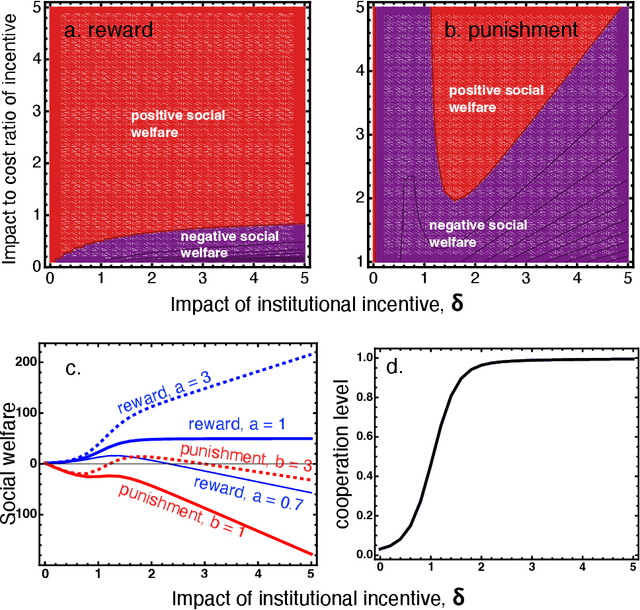
Abstract:Understanding the emergence of prosocial behaviours among self-interested individuals is an important problem in many scientific disciplines. Various mechanisms have been proposed to explain the evolution of such behaviours, primarily seeking the conditions under which a given mechanism can induce highest levels of cooperation. As these mechanisms usually involve costs that alter individual payoffs, it is however possible that aiming for highest levels of cooperation might be detrimental for social welfare -- the later broadly defined as the total population payoff, taking into account all costs involved for inducing increased prosocial behaviours. Herein, by comparatively analysing the social welfare and cooperation levels obtained from stochastic evolutionary models of two well-established mechanisms of prosocial behaviour, namely, peer and institutional incentives, we demonstrate exactly that. We show that the objectives of maximising cooperation levels and the objectives of maximising social welfare are often misaligned. We argue for the need of adopting social welfare as the main optimisation objective when designing and implementing evolutionary mechanisms for social and collective goods.
Trust AI Regulation? Discerning users are vital to build trust and effective AI regulation
Mar 14, 2024Abstract:There is general agreement that some form of regulation is necessary both for AI creators to be incentivised to develop trustworthy systems, and for users to actually trust those systems. But there is much debate about what form these regulations should take and how they should be implemented. Most work in this area has been qualitative, and has not been able to make formal predictions. Here, we propose that evolutionary game theory can be used to quantitatively model the dilemmas faced by users, AI creators, and regulators, and provide insights into the possible effects of different regulatory regimes. We show that creating trustworthy AI and user trust requires regulators to be incentivised to regulate effectively. We demonstrate the effectiveness of two mechanisms that can achieve this. The first is where governments can recognise and reward regulators that do a good job. In that case, if the AI system is not too risky for users then some level of trustworthy development and user trust evolves. We then consider an alternative solution, where users can condition their trust decision on the effectiveness of the regulators. This leads to effective regulation, and consequently the development of trustworthy AI and user trust, provided that the cost of implementing regulations is not too high. Our findings highlight the importance of considering the effect of different regulatory regimes from an evolutionary game theoretic perspective.
 Add to Chrome
Add to Chrome Add to Firefox
Add to Firefox Add to Edge
Add to Edge